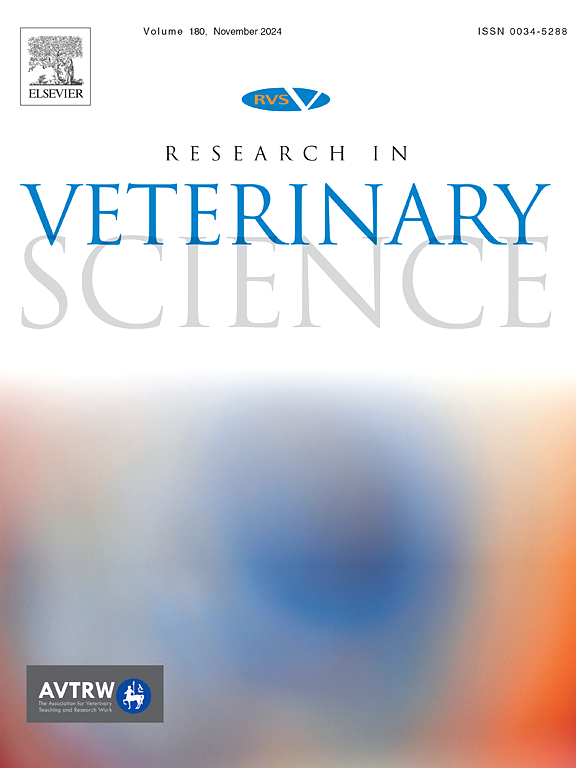Collision tumor of myeloma and infiltrative lipoma in the canine spine
IF 2.2
3区 农林科学
Q1 VETERINARY SCIENCES
引用次数: 0
Abstract
Collision tumor is a rare phenomenon in dogs, defined by the coexistence of two distinct neoplasms at the same anatomic site, with no previous reports of multiple myeloma (MM) and infiltrative lipoma collision in dogs. MM is a malignant plasma cell neoplasm, accounting for less than 1 % of canine malignant tumors, primarily affecting the axial skeleton with osteolytic lesions. Infiltrative lipomas can invade adjacent tissues, including the spinal canal, leading to neurological deficits. This study describes a case of tumor collision between MM and infiltrative lipoma in the spine of a 14-year-old mixed-breed dog with a three-month history of lumbosacral swelling and progressive neurological deficits, emphasizing the importance of a thorough diagnostic approach for effective treatment. Myelography revealed extensive osteolysis of the fourth, fifth and sixth lumbar vertebrae, along with a sudden contrast interruption and a filling defect at L6, prompting surgical intervention for tumor excision and cauda equina decompression. During surgery, meticulous tissue sampling from the subcutaneous layer to the epidural fat enabled histopathological identification of MM infiltrating beyond L6 and coexisting with an infiltrative lipoma. MM was confirmed by monoclonal gammopathy detected via serum protein electrophoresis. Following diagnosis, treatment with melphalan and prednisone resulted in pain resolution and reduced serum gamma globulin levels. After 925 days of follow-up, the dog remains clinically stable with no recurrence of clinical signs. This case underscores the critical role of accurate diagnosis in identifying tumor collisions, guiding targeted treatment, and improving survival outcomes.
犬脊柱骨髓瘤与浸润性脂肪瘤碰撞瘤
碰撞瘤在犬类中是一种罕见的现象,定义为在同一解剖部位同时存在两种不同的肿瘤,此前未见犬类多发性骨髓瘤(MM)和浸润性脂肪瘤碰撞的报道。MM是一种恶性浆细胞肿瘤,占犬恶性肿瘤的不到1%,主要累及中轴骨骼,伴溶骨病变。浸润性脂肪瘤可侵入邻近组织,包括椎管,导致神经功能缺损。本研究描述了一个14岁的混血犬脊柱MM与浸润性脂肪瘤之间的肿瘤碰撞病例,该病例有三个月的腰骶肿胀史和进行性神经功能障碍,强调了彻底诊断方法对有效治疗的重要性。脊髓造影显示第4、第5和第6腰椎广泛骨溶解,并伴有突然造影剂中断和第6腰椎充血缺损,促使手术干预肿瘤切除和马尾减压。在手术过程中,从皮下到硬膜外脂肪的细致组织取样使组织病理学鉴定MM浸润超过L6并与浸润性脂肪瘤共存。血清蛋白电泳单克隆γ病检测证实MM。诊断后,用美法兰和强的松治疗导致疼痛缓解和血清丙种球蛋白水平降低。随访925天后,临床情况稳定,无临床症状复发。该病例强调了准确诊断在识别肿瘤碰撞、指导靶向治疗和提高生存率方面的关键作用。
本文章由计算机程序翻译,如有差异,请以英文原文为准。
求助全文
约1分钟内获得全文
求助全文
来源期刊

Research in veterinary science
农林科学-兽医学
CiteScore
4.40
自引率
4.20%
发文量
312
审稿时长
75 days
期刊介绍:
Research in Veterinary Science is an International multi-disciplinary journal publishing original articles, reviews and short communications of a high scientific and ethical standard in all aspects of veterinary and biomedical research.
The primary aim of the journal is to inform veterinary and biomedical scientists of significant advances in veterinary and related research through prompt publication and dissemination. Secondly, the journal aims to provide a general multi-disciplinary forum for discussion and debate of news and issues concerning veterinary science. Thirdly, to promote the dissemination of knowledge to a broader range of professions, globally.
High quality papers on all species of animals are considered, particularly those considered to be of high scientific importance and originality, and with interdisciplinary interest. The journal encourages papers providing results that have clear implications for understanding disease pathogenesis and for the development of control measures or treatments, as well as those dealing with a comparative biomedical approach, which represents a substantial improvement to animal and human health.
Studies without a robust scientific hypothesis or that are preliminary, or of weak originality, as well as negative results, are not appropriate for the journal. Furthermore, observational approaches, case studies or field reports lacking an advancement in general knowledge do not fall within the scope of the journal.
 求助内容:
求助内容: 应助结果提醒方式:
应助结果提醒方式:


